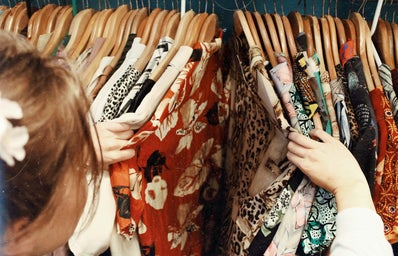It was my junior year of high school while I was shopping for my prom dress when I first realized women’s clothing sizes are complete and utter BS. I remember the frustration I felt as I stood in front of various dressing room mirrors, puzzling over the fact that a size two could be too large for me and a size eight could be too small. Perhaps even more laughable was the fact that I ended up choosing a dress that was labeled petite. At 5’6 I never thought I would shop in the petite section.
So what exactly is the deal with women’s clothing sizes? How are they determined and why are there such frustrating discrepancies? It turns out that there’s a long and complicated history of women’s clothing sizes. The first standardized women’s clothing sizes were introduced in the late 1950s; 15,000 white women were measured by their bust, waist, hips, and girth of their arms in various places. Researchers then attempted to find patterns among these women in order to produce clothing that could be mass-produced and fit a large percentage of them without needing to measure each woman individually. The final results were standardized sizes ranging from 8 to 42, but of course, this system failed in numerous aspects—most importantly, it failed to account for the diverse shapes of women’s bodies.
To make matters even more confusing, many clothing brands engage in a process known as vanity sizing, in which they label clothes as smaller than their actual sizes in order to make customers feel good about themselves when they buy them. This certainly explains why my mom’s size 10 top from the 80s fits me like a glove when I usually fall somewhere in the 4-6 range in today’s clothing stores.
Despite all of this, there’s still an underlying expectation within the clothing industry that women can fit into a universal size and find clothing according to these arbitrary labels. But if you’re like me, you may have noticed that you regularly fall between sizes. Even worse, you may have found that part of your body fits a size eight while another part is a size 12. How are we supposed to find clothes that fit just right when we can’t even fit into the industry’s standard of sizing?
Below, I’ve listed a few of my tips and tricks.
Focus on Materials
Some materials, particularly the stretchy ones like spandex and stretchy denim, will be more generous if you shop smaller. Clothes that are less stretchy don’t exactly give you this sort of leeway and it’s best to shop bigger for these.
Consider the Article of Clothing
Some clothes look better when they’re slightly oversized and some look good when they’re a little tight. For example, a jacket that’s slightly too small looks a lot goofier than a T-shirt or tank top that pulls a little tight in some places. Think about the article of clothing you’re buying and what you would wear with it, and let this guide your decision in whether you want to size up or size down.
Buy Clothing that Cinches or Includes Adjustable Elements
As a girl with broad shoulders, muscular thighs, and a narrow-ish waist, I always breathe a sigh of relief when I see dresses, tops, or pants that come with a built-in belt or tie. These sorts of clothes allow a great amount of flexibility in regards to size. Simply find the article of clothing that fits the largest part of your body, and then adjust the straps or waistline as necessary to meet your fit.
Invest in accessories
Similarly, if you can’t find clothes that have built-in adjustable elements, buy some accessories that will help you out. A cute belt can go a long way, and even some dazzling jewelry can distract from clothes that look a little funky.
And if all else fails, go for intentionally tight or oversized looks
You’ve likely noticed the trend towards baggier T-shirts and jeans, Billie Eilish inspired. Trends like these make it easier for us gals to look fashionable even when we’re between sizes. If you want a fit to be noticeably oversized, choose clothes that are 1 or even 2 sizes larger than what might be typical for you, depending on the brand and style you’re going for. Likewise, if you want a fit to be noticeably tight, size down.
The clothing industry certainly hasn’t made it easier for women to find clothes that fit, even if that was their original intention. Shopping can feel like a Herculean task at times, but the most important thing to remember is this: size is a silly and arbitrary number that ultimately has very little value in the quest for finding clothes that fit. My own closet includes clothes that range from XS to XL, zero to 10, and each brand seems to have different ideas as to how wide the waistline should be, how long the sleeves should be, and the proper hip-to-ankle ratio. Don’t stress too much about which number is printed on the inside of your next sundress, pair of jeans, or blouse—simply find what fits you best, and rock it with confidence.

